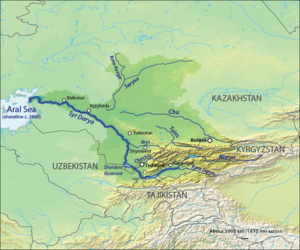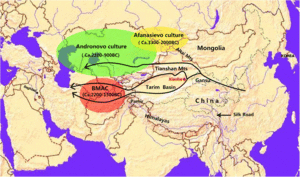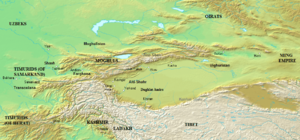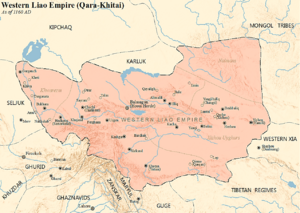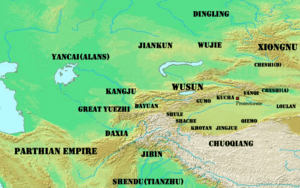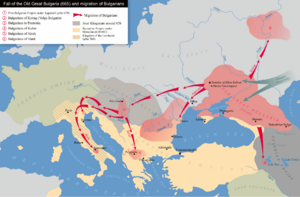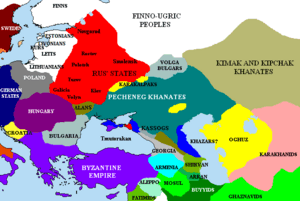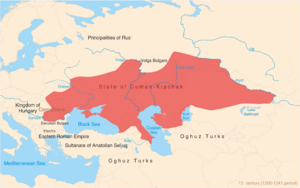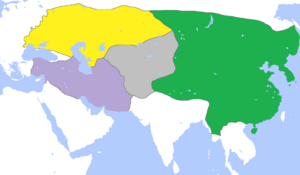History of the central steppe facts for kids
This article explores the fascinating history of the central steppe, a vast grassland area that is mostly modern-day Kazakhstan. The history of this region is quite complex, so this article will give you a simple overview. It connects to the stories of the western and eastern parts of the steppe, and also to the broader History of Kazakhstan and History of Central Asia.
Contents
Understanding the Central Steppe's Geography
The "central steppe" is a huge area of flat, grassy land in the middle of Eurasia. It has some semi-desert areas, getting drier as you go south. To the east, low mountains near the Chinese border separate it from Dzungaria and the eastern steppe. To the west, it blends into the western steppe where the land narrows between the Ural Mountains and the Caspian Sea.
Natural Boundaries of the Steppe
To the north, thick forests of Siberia form a clear boundary. The southern edge has three parts. In the east, the Tian Shan mountains in Kyrgyzstan create a sharp border. In the center, the Syr Darya river flows from the eastern mountains northwest to the Aral Sea. South of this river, the land becomes semi-desert, but ancient cities used irrigation to grow crops. The western part, between the Aral and Caspian Seas, is very dry and has few people. While the Syr Darya and the area between the Urals and Caspian were not big barriers, the other boundaries made it harder for people to move around.
General Facts About the Central Steppe
The central steppe was far from places with written records, so its early history is not well known. Many "peoples" mentioned were actually tribes or clans that became powerful. Some were true ethnic groups, and some movements were real migrations, but often we are not sure. Most dates are approximate because events happened over time or were not well recorded.
Major Historical Patterns
Historians have noticed two big patterns. For the last 2,500 years, most movements on the steppe have been from east to west. Also, around 1000 BC, all known peoples in the western and central steppe spoke Iranian languages. But by 500 AD, Turkic languages spread from Mongolia and replaced most of the Iranian languages.
Before Written History: Early Cultures
We don't fully understand how pastoral nomadism (herding animals while moving around) and horse archery (fighting on horseback with bows) began. Long ago, people who looked European lived in or crossed the central steppe. They left behind the Tarim mummies in the Tarim basin.
Ancient Cultures and Language Spreads
Around 3000 BC, the Yamnaya culture, a semi-nomadic group likely speaking Indo-European languages, appeared west of the central steppe. To its east was the similar Afanasevo culture. These cultures are probably linked to how Indo-European languages, especially Tokharian, spread eastward. Between them, the Botai culture on the central steppe used horses. After 2000 BC, the Andronovo Culture complex emerged southeast of the Urals. They used chariots, built fortified towns, and spread across much of Central Asia. They are linked to the rise of Indo-Iranian languages. Iron tools appeared around 1000 BC. Around 500 BC, the Greek historian Herodotus vaguely described the area as home to the Massagetae and others. By 200 BC, Chinese reports from the east started to provide more information.
Eastern Third: Zhetysu or Semirechye
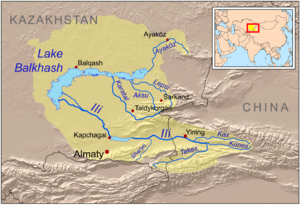
This area, north of the Tian Shan mountains, is special because we have more records about it. Many different peoples moved through it. It's like a "bay" of steppe land, surrounded by Siberian forests to the north, Kyrgyz mountains to the south, and low mountains to the east. Zhetysu is a Turkic word, and Semirechye (meaning "seven rivers" in Russian) refers to this region.
Early Nomadic Groups and Chinese Influence
- Sakas (before 200 BC): These were Iranian-speaking nomads in the western and central steppe. The Greeks called them Scythians, the Persians called them Sakas, and the Chinese called them Sai. These names all mean similar things. Sakas also lived in the western Tarim basin.
- Chinese Expansion (125 BC - 100 AD): The Han dynasty of China expanded westward. In 125 BC, Zhang Qian brought back the first reports of the "Western Regions." From about 100 BC to 100 AD, the Chinese controlled the Tarim Basin, southeast of the central steppe. Chinese historians gave us the earliest good written information about the central steppe.
- Yuezhi (around 162-132 BC): The Yuezhi were a powerful group from Gansu and Mongolia. Around 162 BC, the Xiongnu drove them west, and they settled in the Ili valley. Around 132 BC, the Wusun drove them out, and they moved south. Later, they formed a major state in Bactria called the Kushans.
- Wusun (around 133 BC - 100 AD): The Wusun from Gansu forced the Yuezhi out of the Ili valley. By about 80 BC, they had some power in the Tarim basin. After 100 AD, their power declined, and they slowly disappeared from records.
- Xiongnu (around 40 BC - 155 AD): When the Northern Xiongnu were pushed west by the Chinese, they took over Dzungaria and Semirechye. The Xianbei, who defeated them, might also have reached this area.
- Yueban (around 160-490 AD): After the Han dynasty lost control of the Tarim basin, written sources became scarce. The Chinese called the local people Yueban. They seem to have been what was left of the Xiongnu.
- Ephthalites (around 493-560 AD): These people are not well documented. They were based in the south but might have extended north of the Tian Shan mountains.
- Tiele people (around 100-800 AD): Tiele was a general Chinese term for Turkic peoples living mainly on the northern edge of the steppe, from Mongolia westward.
New Empires and Religions in Zhetysu
- Outside Influences (around 500-800 AD): Turkic-speaking peoples spread from Mongolia and took over the central steppe. The Chinese returned under the Tang dynasty (618-907 AD). Islam arrived around 750 AD. Meanwhile, merchants from Sogdia controlled most of the long-distance trade.
- Gokturks (around 558-657 AD): The Gokturks were the first Turkic-speakers to create a large empire. They were also the first to rule both the eastern and central steppe. In 552 AD, they took over Mongolia. By 558 AD, they reached the Volga River, and by 571 AD, they reached the Oxus River. By 603 AD, the Western Turkic Khaganate had clearly separated from the Eastern Khaganate in Mongolia. Around 657 AD, the Chinese defeated them.
- Chinese Return (around 657-756 AD): The Tang dynasty brought back Chinese power. The Tang took over the Tarim basin and the mountains of Kyrgyzstan. They captured Tashkent, brought the remaining Western Turks under their control, and then lost a battle to the Arabs in 751 AD. Around 756 AD, they pulled back because of the An Lushan rebellion.
- Islam's Arrival (around 750 AD - present): After the Arabs conquered Merv in 651 AD, they started raiding northward. From 705 AD, Islam expanded into the area between the Oxus and Syr Darya rivers. Muslims in Central Asia soon became more Persian than Arab. From about 750 AD, Islam slowly spread north of the Syr Darya and into the Tarim Basin.
- Sogdian Merchants (around 300-840 AD): Merchants from Sogdia controlled most of the trade between China and the west. They had settlements all the way from Bukhara to northern China.
- Turgesh (around 699-766 AD): The Turgesh were a group of Dulu Turks who brought back a type of Turkic Khaganate. They fought against both the Arabs and the Chinese.
- Karluks (around 766-840 AD): The Turkic Karluks drove the Turgesh out of Semirechye. They later became the Karakhanids. As a tribe, they started in Dzungaria and existed from at least 644 AD into Mongol times.
- Karakhanids (around 850-1134 AD): Karluks and other groups founded the Karakhanid Khaganate. Around 960 AD, the Karakhanids adopted Islam. Around 999 AD, they conquered Transoxiana. About 1041 AD, they split into an eastern group in Semirechye and a western group in Transoxiana. By 1081 AD, they were vassals of the Seljuk Empire, at least in theory. After their defeat in 1134 AD, many Karakhanids remained as local rulers.
Later Powers in Zhetysu
- Karakitai (1134-1220 AD): The Karakitai rulers were refugees from northern China. These Manchurian Kitans had ruled northern China as the Liao dynasty (907-1125 AD). After the Jurchens overthrew them, some Kitan survivors fled west. They conquered Semirechye in 1134 AD. By 1141 AD, they controlled most of the Karakhanids' lands. They were not Muslim and had some Chinese culture. They usually let the old rulers stay in power as their vassals. In 1211 AD, a Naiman prince who had fled the Mongols took power. The Mongols chased him, and by 1220 AD, they had conquered most of the Karakitai lands.
- Mongols and After: After the Mongol conquest of the area in 1220 AD, the eastern third of the central steppe was no longer treated separately. You can read about it in the "Mongols and After" section below.
- Chagataids: When the Mongol empire split up, Central Asia went to the Chagataids in 1266 AD. However, they never formed a strong state and soon adopted Islam and the local language.
- Moghulistan (around 1450-1500 AD): Moghulistan emerged from the weakening Chagatai Khanate. Zhetysu became split between Moghulistan in the east and the rising Kazakhs.
- Kazakhs (1465 AD - present): The Kazakhs first appeared in Zhetysu and soon spread their name across the entire central steppe. Semirechye was under the Senior Horde of the Kazakhs.
- Dzungar Khanate (around 1680-1758 AD): This group held the area until the Chinese destroyed them.
- Russian Conquest (1847-1868 AD): The Russians conquered the area from the north. See Russian conquest of Turkestan.
Western Two-Thirds and Turkic Migrations
This part of the steppe was far from places with written history, so information is scarce.
Early Peoples and Empires
- Greek and Persian Reports (around 500 BC): The so-called Pointed-Hat Sakas might have lived along the upper Syr Darya. The Dahae lived between the Caspian and Aral Seas. The Massagatae probably lived east of the Aral Sea. Herodotus vaguely mentioned the Issedones and others.
- Chinese Reports (125 BC): The first Chinese reports appeared in 125 BC. The Kangju lived along the Syr Darya, and the Yancai probably lived north of the Aral Sea. The Yancai might have been the Greek's Sarmatians, specifically the Alans. All these groups were independent of the Persian and Macedonian Empires to the south.
- Huns (before 370 AD): The Huns formed somewhere in Central Asia. They crossed the Volga River around 370 AD and raided the Roman Empire. They were likely a mix of Xiongnu and other peoples.
- Bulgars (2nd century AD - 7th century AD): The Bulgars, originally nomads from Central Asia, lived in the Pontic steppe north of the Caucasus from the 2nd century. They formed Old Great Bulgaria (632-668 AD). Later, pushed by the Khazars, most of them moved west. They took over Byzantine lands along the lower Danube from the 7th century, forming Bulgaria.
- First Turkic Khaganate (552-659 AD): The first Turkic Khaganate started in Mongolia and quickly spread to the Volga. It soon split, and the central steppe became the Western Turkic Khaganate. This Khaganate had two main groups: the Dulu Turks south of Lake Balkhash and the Nushibi between them and the Kangars east of the Aral Sea.
Waves of Turkic Migrations
- Turkic Migrations (around 500-1100 AD): Turkic speakers moved west in three main waves. The Oghurs disappeared, the Oghuz went southwest (leaving their languages in Turkmenistan and Turkey), and the Kipchaks took over the entire central and western steppe. The Karluks stayed in the east and moved a bit southwest. Since records often only mention the ruling class, we don't know how long Iranian languages survived among common people on the steppe. South of the Syr Darya, Turkic slave-soldiers started appearing around 800 AD. This and other reasons helped Turkic languages spread south of the Syr Darya, replacing most Iranian languages there.
- Oghur: Around 500 AD, before the Turkic Khaganate, the Oghur might have been north of the Aral Sea. They continued west and founded several kingdoms around the western steppe. Their languages have mostly disappeared, except for the Chuvash language.
- Oghuz: Around 700 AD, after the Turkic Khaganate fell, the Oghuz Turks appeared north of Lake Balkhash. They were east of the Oghurs and west of the Karluks and Kipchaks. Before 900 AD, they reached the Aral Sea and soon moved south on both sides of it, possibly pushed by the Kipchaks. Muslim Oghuz became known as Turkomans. Led by the Seljuks, they moved south and west, taking over Turkmenistan and giving their language and religion to modern Turkey. Oghuz who went west and fought Kievan Rus were called Pechenegs.
- Kipchak: Around 700 AD, after the Turkic Khaganate fell, the Kipchaks emerged in western Dzungaria, north of the Karluks. Before 900 AD, they had replaced the Oghuz north of Lake Balkhash and were connected to the Kimeks to their north. By 1000 AD, they reached the Aral Sea, and by 1100 AD, the Volga River. They continued west and occupied the entire western steppe, where they were known as Cumans and Polovtsi. They might have been ruled by the Kimeks at some point. Starting around 1500 AD, Russians and Ukrainians pushed them off the western steppe, but they stayed on the central steppe and became the Kazakhs.
- Four Peoples on the Lower Syr Darya: After the Gokturks fell, the Kangar union (659-750 AD?) was based on the lower Syr Darya. They might have been a revived Kangju group under Turkic rule. The Pechenegs (750-790 AD, very uncertain) were either Kangars or replaced them. From about 775 AD, the Oghuz drove them west, where they fought Kievan Rus. Around 790 AD, one of the Oghuz leaders took the title of Yabgu. Around 985 AD, one of his subjects broke away and founded the Seljuks. The so-called Oghuz Yabgu State was overthrown by the Seljuks in 1043 AD. They were followed by the Qangli, who lasted until the Mongol conquest.
Mongols and After: Shaping Modern Kazakhstan
- Mongol Empire (1206-1294 AD): The Mongol Empire was founded in 1206 AD. It reached the Ural River around 1223 AD and the edge of Eastern Europe by 1240 AD.
- Golden Horde (around 1241-1504 AD): The Mongol Empire slowly split into four parts. The western and central steppe became the Golden Horde. (However, the Chagataids held Semirechye and the land south of the Syr Darya.) Within a hundred years, they adopted Islam and the Kipchak language of the people they ruled. They were strongest before 1350 AD but then weakened due to internal fights. They lost outer areas and eventually broke up, with the last khan dying around 1504 AD.
- Abul-Khayr Khan (around 1428-1467 AD): As the Golden Horde was breaking up, Abu'l-Khayr Khan, a descendant of Batu's brother, briefly united the area from the Aral Sea north toward Siberia and east toward Lake Balkash. The term Uzbek appeared around this time, originally meaning something like a Shaybanid (Abu'l-Khayr's family) and later used for Turkic speakers along the Oxus River.
- Kazakhs (around 1460 AD - present): A group of Abu'l-Khayr's people broke away and settled in Semirechye. They became known as Uzbek-Kazakhs, meaning "free Uzbeks." Because of the problems after Abu'l-Khayr's death, more Uzbeks joined them, and the name Kazakh spread across the entire central steppe. After about 1718 AD, they divided into three Zhuzes (hordes). The Russians slowly gained power from 1730 AD, and in 1845 AD, the title of Khan was officially ended. Kazakhstan became an independent country in 1991.
- Nogai Horde (around 1500 AD): Around 1500 AD, the Kipchaks north of the Caspian Sea became known as the Nogai Horde. Their name spread to all Kipchaks west of the Kazakhs. Those on the western steppe were slowly defeated by the Russians, while those on the central steppe seem to have joined the Kazakhs and Kalmyks.
- Kalmyks (1618-1771 AD): The Kalmyks were Buddhist Mongols from Dzungaria. In 1618 AD, they crossed the central steppe and settled north of the Caspian. In 1771 AD, some of them returned to Dzungaria.
- Russian Influence (around 1743-1991 AD): From 1582 to 1639 AD, Russians took control of the Siberian forests. In 1743 AD, they founded Orenburg on the Ural River. From there, they watched the steppe and slowly gained control of the Kazakh lands. See Russian conquest of Turkestan. Some Russian farmers settled along the northern steppe. Western civilization, in its Russian or Soviet form, changed daily life. The industrial revolution made steppe nomadism outdated for both economy and military. From 1953 to 1962 AD, the Virgin lands campaign brought many Russians and Ukrainians to northern Kazakhstan.


